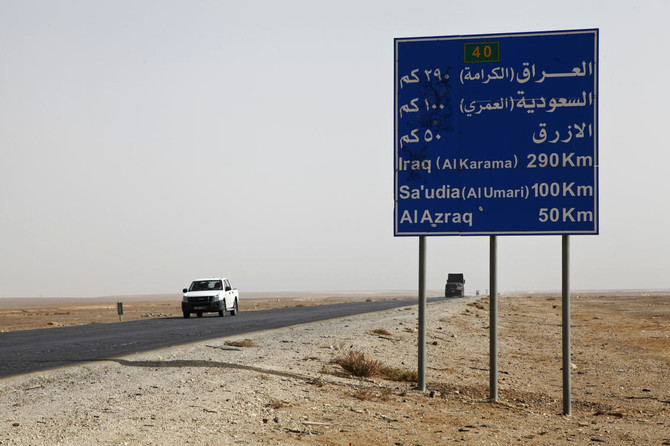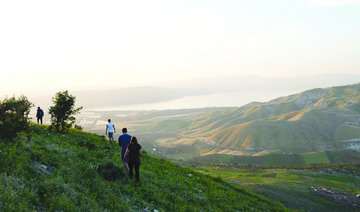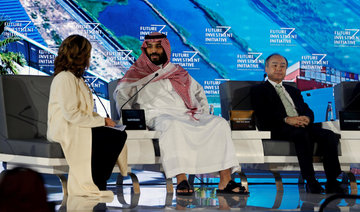MADOUNEH, Jordan: A shiny new city is to arise from Jordan’s desert over the next three decades, potentially rivaling the kingdom’s capital of Amman, a rapidly growing and increasingly unwieldy metropolis of 4 million people.
Announcing plans for what it portrays as a high-tech utopia, Jordan joined other Middle Eastern countries betting on multi-million-dollar mega projects as an investment magnet and quick economic fix.
Yet some urban planners warn that “cities from scratch” are risky endeavors and argue it’s more efficient to improve existing cities.
In Jordan, the government promises the yet-to-be-named city will draw population away from Amman, relieve its crippling traffic jams, provide middle-class housing and inject momentum into a sluggish economy plagued by high unemployment.
But authorities have released only snippets of information since the prime minister mentioned the new city for the first time, seemingly casually, in a meeting with local journalists in late October.
This perceived secrecy and “top-down” approach has drawn widespread criticism.
Few Jordanians have shown much enthusiasm, even among Amman residents who complain constantly of the city’s traffic. Some suspect the new city is largely meant to benefit Jordan’s powerful and their business cronies. Government officials deny that.
This week, Amman Mayor Yousef Shawarbeh defended the rocky rollout in a meeting with business people, diplomats and representatives of the energy and environmental sectors, many of whom seemed skeptical.
“The topic hasn’t been fully studied yet,” the mayor said when pressed for details. “When we conclude the studies, we will announce plans and have clear roles for government, citizens, investors, and so on.”
Shawarbeh insisted that Amman would not be neglected as Jordan, buckling under record public debt, shifts scarce resources to the new project. “The new city is not a new Amman,” he said. But it is needed, he argued, to relieve pressure on the capital.
Amman was a hamlet just a century ago and is seen as an upstart among the region’s ancient cities, such as Baghdad and Cairo. Today, Amman is home to more than 40 percent of Jordan’s population of 9.5 million.
Almost every hour of the day is rush hour and urban sprawl is rapidly devouring precious green areas. Districts of mid-rise, sand-covered residential buildings spread over hills and valleys, with a few high-rise towers marking the city center.
Rapid growth has been driven by an influx of hundreds of thousands of Palestinian, Syrian and Iraqi refugees in recent decades.
It is also linked to accelerated urbanization across the Middle East and North Africa, where populations flock from underdeveloped rural areas into cities looking for greater job opportunities. By 2050, more than two-thirds of the region’s anticipated 646 million people will live in cities, compared to 56 percent of 357 million people in 2010, according to UN projections.
In the past two decades, some two dozen new city projects were announced in the Middle East. About half remain “power point cities” existing only on websites, said Sarah Moser, an urban geography professor at McGill University in Montreal. Others are well behind schedule.
She said builders of new cities often underestimate challenges, including raising huge sums of capital and finding the necessary expertise. In such for-profit enterprises, plans for less lucrative public transport systems often remain on paper.
“I would suggest Jordan proceed with caution,” Moser said.
Egypt’s multi-billion-dollar plan for a new capital, announced in 2015, fell behind schedule after the country switched contractors. But President Abdel Fattah El-Sisi is determined to forge ahead. He plans to rule from the new city by 2019, leaving behind unruly Cairo, the Arab world’s largest city.
When pressed why the government is spending huge sums at a time of economic hardship, he said recently: “Isn’t it our right to have a dream? Is it wrong to have 13 cities like this or what? Don’t we deserve it?“
Several planned cities did advance over the years, including King Abdullah Economic City in Saudi Arabia, Modiin in Israel and Rawabi in the Palestinian territories.
Jordan’s new city would be built about 30 kilometers east of Amman on a desolate desert plain flanked by roads leading to Saudi Arabia, Iraq and — in the future — the country’s main airport. It’s to be built as a public-private partnership on state land, with first tenders to be submitted by mid-2018.
Officials have said little about how it will look other than describing it as a “smart city” running on renewable energy and boasting public transport. Eventually it would cover 390 square kilometers, an area a little smaller than the borough of Queens in New York City.
The first phase is to be completed by 2030 and the entire project by 2050, but the government has not announced a target population size. Many government departments and public institutions are to relocate there, it said. Housing cooperatives of civil servants, professionals and former members of the security forces would be able to build in the new city.
During a visit last week, the earmarked area was largely deserted, except for the occasional truck and car passing. The closest human activity is a truck station called Madouneh, though further out in the deserts beyond the site lie the Azraq camp for Syrian refugees, a military base and scattered abandoned ancient fortresses called qasrs.
The city is meant to ease overcrowding in Amman and Zarqa, a working-class city of 1.3 million. With urban sprawl, the two cities have been growing toward each other and are expected to have a combined population of 10 million by 2050.
Some suspect that the urban construction plans are largely meant to distract from economic problems, including tax hikes and further subsidy cuts, including for bread. “It makes people busy with a long-term vision” at a time of painful fiscal decisions, said political analyst Amer Sabaileh.
Critics also predict it will sap any development in Amman and Jordan’s other cities, chaotic and decidedly not high-tech and gleaming.
“Our cities should be developed, instead of building another one,” said Maram Tawil, an urban planning professor at the German-Jordanian University in Amman.
Tawil and colleagues at her university propose, among other things, to create service centers in urban neighborhoods to relieve traffic pressure on the city center and help save green spaces.
Tawil called on city planners to look for strategic solutions, saying that if Amman keeps growing at the current uncontrolled pace, “it will be impossible to live in.”
If it’s business as usual, then “a new Amman will be needed,” she said.
Jordan says planned city in the desert will not be ‘new Amman’
Jordan says planned city in the desert will not be ‘new Amman’

US-UK forces launch strikes on Yemen’s Hodeidah and Kamaran Island: Houthi-run Al Masirah TV

- Despite reprisals from US-British coalition, Houthis have in recent months escalated campaign of attacks in Red Sea
CAIRO: US and British forces have carried out at least six airstrikes on Yemen’s Hodeidah International Airport and four strikes on Kamaran Island near the port of Salif off the Red Sea, Al-Masirah TV, the main television news outlet run by Yemen’s Houthi movement, said on Monday.
The strikes on Kamaran mark the first time US-led coalition forces have targeted the island since airstrikes on Houthi targets began in early February.
Yemen’s internationally-recognized government believes Houthi fighters in the past have used Kamaran Island and Port Salif as a site to launch their Red Sea attacks as well as hide stockpiles of missiles and drones in its salt mines, two military sources within the government told Reuters.
The 10-kilometers of water that stretch from the port of Salif to Kamaran Island are also part of the route that ships must transit through to reach their next port of call.
The Houthis, who control Yemen’s capital and most populous areas, have attacked international shipping in the Red Sea since November in solidarity with Palestinians in Gaza.
Despite reprisals from the US-British coalition and other navies, the Houthis have in recent months escalated their campaign of attacks on commercial vessels in one of the world’s busiest shipping lanes.
Displaced Lebanese return to southern border to mourn, pray over Eid

- Israel and Hezbollah have traded near-daily cross-border fire since Hamas’ Oct. 7 attack
NAQURA, Lebanon: Some displaced residents of southern Lebanon returned Monday to their towns for a key Muslim holiday to pray and mourn loved ones killed in months of cross-border violence between Israel and Hezbollah.
“Today is Eid Al-Adha, but it’s completely different this year,” said teacher Rabab Yazbek, 44, at a cemetery in the coastal town of Naqura, from which many residents have fled.
Every family has lost someone, “whether a relative, friend or neighbor,” Yazbek said, adding that two people she had taught had been killed.
Israel and Hezbollah, a powerful Lebanese movement allied with Hamas, have traded near-daily cross-border fire since the Palestinian militant group’s October 7 attack on Israel which triggered war in the Gaza Strip.
The violence has killed at least 473 people in Lebanon, most of them fighters but also including 92 civilians, according to an AFP tally.
Israeli authorities say at least 15 soldiers and 11 civilians have been killed in the country’s north.
At the cemetery, women in black chadors consoled each other at the shiny new graves adorned with flowers and large pictures of the dead, including Hezbollah fighters.
The Naqura municipality said it had coordinated with the Lebanese army so that residents could safely visit the cemetery and mosque for two hours for Eid Al-Adha, which for many Shiite Muslims in Lebanon began on Monday.
Residents reportedly returned to a number of south Lebanon border villages on Monday morning as part of similar initiatives.
Yellow Hezbollah flags and green ones belonging to the group’s ally the Amal movement flew at the recently established cemetery near the sea, located just a stone’s throw from the United Nations peacekeepers’ headquarters.
Lebanese soldiers accompanied the residents as they entered the town.
The army coordinates with the UN peacekeepers, who in turn communicate with the Israeli side as part of efforts to maintain calm.
In Naqura, a damaged sign reading “thank you for your visit” lay along the highway.
Amid the concrete rubble and twisted metal of one building, the shattered glass of a family photo lay scattered on the ground.
Nearby, potted plants hung from the veranda rails of another devastated structure, with a pink child’s toy car among the debris.
Rawand Yazbek, 50, was inspecting her clothing shop, whose glass store front had been destroyed, though the rest remained largely intact.
“A thousand thanks to God,” she said, grateful that not all was lost.
“As you can see... our stores are full of goods,” she said, pointing to shelves and racks of colorful clothes.
Hezbollah stepped up attacks against northern Israel last week after an Israeli strike killed a senior commander from the movement.
The Iran-backed group has not claimed any attacks since Saturday afternoon.
Lebanese official media reported Israeli bombardment in the country’s south over the weekend, as well as a deadly strike on Monday. Hezbollah said later that one of its fighters had been killed.
Like other residents who support the Hezbollah and Amal movements, Naqura municipality head Abbas Awada called attacks on the town “cowardly.”
Last week, a strike there blamed on Israel killed an employee of the area’s public water company.
More than 95,000 people in Lebanon have been displaced by the hostilities, according to the UN’s International Organization for Migration.
Tens of thousands have also been displaced on the Israeli side of the frontier.
Hezbollah lawmaker Hassan Ezzedine, among a large crowd that attended prayers at the Naqura mosque, said the turnout was a message that “this land is ours, we will not leave it.”
“We support this resistance (Hezbollah) because it’s what protects us, it’s what defends us,” he said.
Palestinian Authority at risk of collapse, Norway says

- Norway chairs the international donor group to the Palestinians and is a backer of the Palestinian Authority
OSLO: The Palestinian Authority could collapse in the coming months, Norwegian Foreign Minister Espen Barth Eide said on Monday, citing a lack of funding, continuing violence and the fact that half a million Palestinians are not allowed to work in Israel.
“The Palestinian Authority, with whom we work closely, are warning us that they might be collapsing this summer,” Barth Eide said.
Norway chairs the international donor group to the Palestinians and is a backer of the PA.
Jordan braces for scorching heatwave as temperatures soar

- The Gulf of Aqaba reached highs of 45 celsius
- Temperatures in Jordan are set to rise slightly, with the heatwave persisting
AMMAN: The Jordan Meteorological Department forecast extreme heat for Monday, with most regions of the country — particularly the desert areas, Jordan Valley, Dead Sea and Aqaba — experiencing intense temperatures.
The Gulf of Aqaba reached highs of 45 celsius, the Southern Jordan Valley 44 celsius, Dead Sea 43 celsius, while the Desert Regions and the Northern Jordan Valley reached highs of 41 celsius.
Cloud cover at medium and high altitudes is expected in the south and east of the Kingdom, state news agency Petra reported, with moderate northwesterly winds occasionally becoming brisk.
The JMD cautioned people against prolonged sun exposure, which could lead to dehydration, especially for vulnerable groups such as the elderly and those with health conditions. It also highlighted the risk of forest fires and the dangers of leaving children or flammable items, like perfumes and sanitizers, inside vehicles.
Looking ahead to Tuesday, temperatures in Jordan are set to rise slightly, with the heatwave persisting. Most areas will remain hot, the JMD said, and desert regions will face sweltering conditions. Northeasterly winds will prevail, shifting to moderate northwesterly by evening.
The heatwave will continue into Wednesday, with another slight increase in temperatures. Conditions will be blistering and dry across the highlands, the JMD warned, with extreme heat persisting elsewhere. Northeasterly winds will turn to moderate northwesterly later in the day.
Thursday will bring a modest reprieve as temperatures dip slightly. However, the weather will remain hot across most areas, with the desert, Jordan Valley, Dead Sea, and Aqaba continuing to sizzle. Moderate northwesterly winds will occasionally become brisk.
Iran calls for joint action by Islamic nations to stop Gaza war

- Israel’s military offensive on Gaza has killed at least 37,337 people so far
TEHRAN: Iran’s Acting Foreign Minister Ali Bagheri Kani has called for joint action on the part of Islamic countries to pressure Israel into ending its brutal military activities in Gaza, which have devastated most of the enclave and killed thousands of Palestinians there.
Israel’s military offensive on Gaza has killed at least 37,337 people, mostly civilian women and children, since the Oct. 7 Hamas attack, according to the Hamas-run Health Ministry in Gaza.
Humanitarian supplies for millions of Palestinians displaced by the conflict have been squeezed despite the Israeli military declaring it would “pause” fighting daily around a southern route to facilitate aid flows.
The Iranian official also spoke with his Afghan counterpart Amir Khan Muttaqi via telephone on Sunday, with the two discussing bilateral relations as well as the situation in war-ravaged Gaza.
Kani reiterated Iran’s readiness to help Kabul resolve its challenges and achieve growth, Iran’s news agency IRNA reported.




















